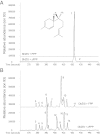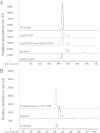Improved herbivore resistance in cultivated tomato with the sesquiterpene biosynthetic pathway from a wild relative
- PMID: 23169639
- PMCID: PMC3523864
- DOI: 10.1073/pnas.1208756109
Improved herbivore resistance in cultivated tomato with the sesquiterpene biosynthetic pathway from a wild relative
Abstract
Tomato breeding has been tremendously efficient in increasing fruit quality and quantity but did not focus on improving herbivore resistance. The biosynthetic pathway for the production of 7-epizingiberene in a wild tomato was introduced into a cultivated greenhouse variety with the aim to obtain herbivore resistance. 7-Epizingiberene is a specific sesquiterpene with toxic and repellent properties that is produced and stored in glandular trichomes. We identified 7-epizingiberene synthase (ShZIS) that belongs to a new class of sesquiterpene synthases, exclusively using Z-Z-farnesyl-diphosphate (zFPP) in plastids, probably arisen through neo-functionalization of a common ancestor. Expression of the ShZIS and zFPP synthases in the glandular trichomes of cultivated tomato resulted in the production of 7-epizingiberene. These tomatoes gained resistance to several herbivores that are pests of tomato. Hence, introduction of this sesquiterpene biosynthetic pathway into cultivated tomatoes resulted in improved herbivore resistance.
Conflict of interest statement
The authors declare no conflict of interest. Description of 7-epizingiberene production and the use of the
Figures




References
-
- Navas-Castillo J, Fiallo-Olivé E, Sánchez-Campos S. Emerging virus diseases transmitted by whiteflies. Annu Rev Phytopathol. 2011;49:219–248. - PubMed
-
- McCaskill D, Croteau R. Strategies for bioengineering the development and metabolism of glandular tissues in plants. Nat Biotechnol. 1999;17(1):31–36. - PubMed
-
- Eigenbrode SD, Trumble JT, Millar JG, White KK. Topical toxicity of tomato sesquiterpenes to the beet armyworm and the role of these compounds in resistance derived from an accession of Lycopersicon hirsutum f. typicum. J Agric Food Chem. 1994;42:807–810.
-
- Frelichowski JE, Jr, Juvik JA. Sesquiterpene carboxylic acids from a wild tomato species affect larval feeding behavior and survival of Helicoverpa zea and Spodoptera exigua (Lepidoptera: Noctuidae) J Econ Entomol. 2001;94(5):1249–1259. - PubMed
-
- Snyder JC, Guo Z, Thacker R, Goodman JP, Pyrek JST. 2,3-Dihydrofarnesoic acid, a unique terpene from trichomes of Lycopersicon hirsutum repels spider mites. J Chem Ecol. 1993;19:2981–2997. - PubMed
Publication types
MeSH terms
Substances
LinkOut - more resources
Full Text Sources
Other Literature Sources

